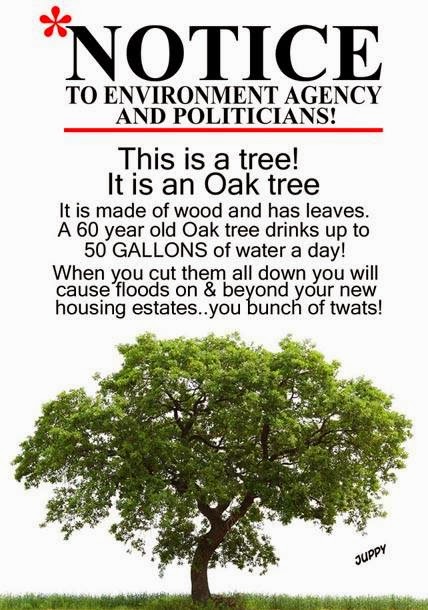 |
| Picture from Mike Jupp |
As always when I see such numbers, though, I feel the urge to check the source, as I am afraid as many as 91% of statistics found on the internet are either wrong or simply made up.*
I have struggled to find anything other than people repeating the 50 gallon figure without sources (though I'll come back to how realistic it is), but I was fascinated to discover this piece of research by the Forestry Commission. Although it doesn't directly confirm the 50 gallon figure, it does (not surprisingly) confirm that trees are about the best thing you can have to reduce water run-off. But the reason I found it fascinating was the detail, looking at different kinds of trees, because it underlines the problem I often have with the green movement.
There is often a tendency to confuse what is 'natural' or sounds more green in a 'hey, let's hug the trees' hippy way with what is better for the environment (this comes through, for instance, in all the myths surrounding organic food). In the UK there is no more natural symbol of a tree than the oak tree, but it's actually not the best tree to reduce flooding. In fact, conifers are significantly better than broad leaf trees like oaks at putting water back into the atmosphere. They also have the advantage of being much quicker to grow. It's all very well for 60-year-old oaks to 'drink' up to 50 gallons, but we haven't got 60 years to wait for new trees to grow. Yes we should preserve existing oaks (which, to be fair, was the point of the graphic), but we should not be planting new ones if this is our aim.
I find this particularly interesting because on the whole the dedicated green types are likely to frown on conifers as being unnatural and not as good as the 'native' species. But if you truly care about the environment, we need a lot more conifers.
I said I couldn't directly confirm the water consumption figure, but I can do a Fermi calculation. Broadleaves achieve between 400 and 640 mm of evaporation from 1 hectare of forest receiving 1000 mm annual rainfall. Let's use the median of 520. The current moving average annual rainfall is about 1175 mm, so that pushes up the consumption to 611 mm/hectare. A typical oak tree is about 13 metres across, so realistically you could get about 40 per hectare (which is 100m x 100m) in a well-covered forest. So the annual volume of water one broadleaf disposes of is 8109942 cc or 81099 litres. That's 222 litres a day, which is 48 gallons. Of course that is all back of the envelope stuff, but it's good enough to see that 50 gallons per day isn't a bad figure.
* If I am honest, this is one of those made up statistics. I picked the number 91 at random. However, because I used the statistical weasel words 'as much as' I am pretty safe, as this basically means anything between 0 and 91. (The same goes for 'up to' which you will see elsewhere above.)
This has been a green heretic production

Comments
Post a Comment